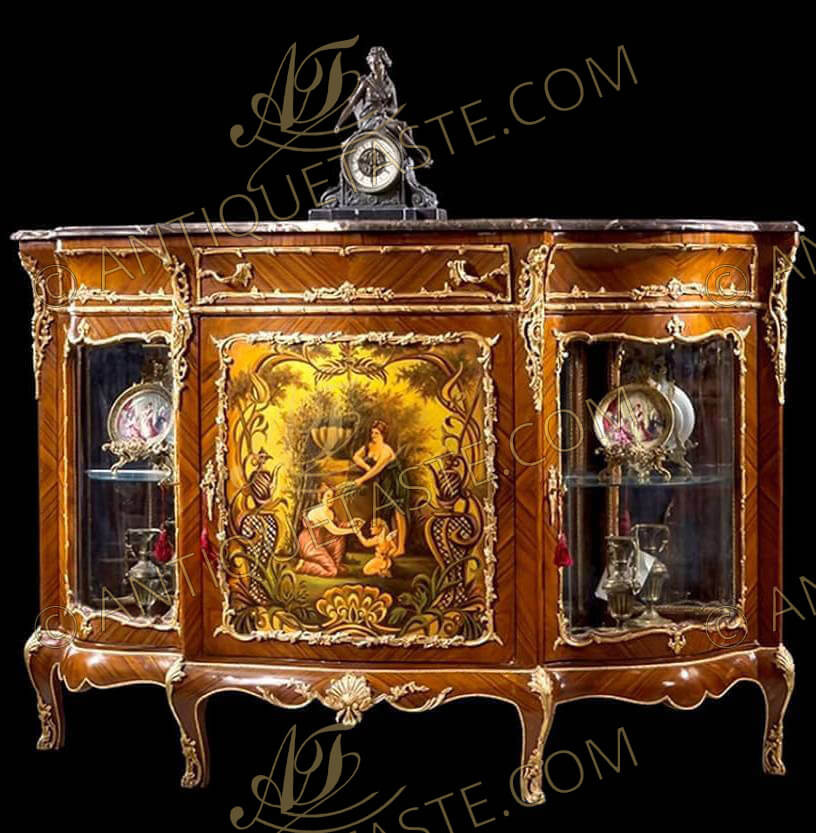Ref#C-1458-V | Description
A luxuriant French Napoléon III gilt-ormolu mounted veneer inlaid and Vernis Martin serpentine shaped side display cabinet, after the model by Henri Picard Circa 1880
The serpentine shaped marble top above an ormolu mounted frieze drawer flanked by two faux drawers to each side surrounded with rich ormolu encadrement, above three cupboard doors. The right and left display doors are flanking the central door which is decorated with a fine painted cartouche with classically dressed nymphs giving water to cupid by a well surrounded with a fine foliate ormolu encadrement. The three doors with ormolu keyhole escutcheons.
The fine piece is raised on four delicate short cabriole legs elaborately decorated with ormolu strap-works, shell and ormolu pierced sabots.
The Vernis -Martin technique became popular again in the later years of the 19th century. Patented by Guillaume and Simon-Etienne Martin in 1748, it was developed to imitate Far Eastern, particularly Japanese, lacquerware. The process uses copal and amber varnishes which are layered onto the desired surface. The varnish is then polished with pumice powder and sealed with oil to create a smooth, glossy finish. Many 19th century painters added a craquelure to the varnish to imitate the original varnish of the Martin brothers as seen over 100 years earlier.
Ref#C-1458-V
175 x 50 x 115cm
The Napoleon III style:
The Napoleon III style is the name commonly given to a 19th-century style of Renaissance Revival architecture in France, especially in Paris. It is a sub-style of Second Empire architecture, which is a term also used elsewhere in the world for this style. It is characterized by its eclecticism, because of the mix of decorative elements from the past. It flourished during the Second French Empire, with the patronage of Napoleon III.
The term "Napoleon III style" (French: style Napoléon III) may be contemporary: legend has it that when the Empress Eugénie asked architect Charles Garnier whether the Palais Garnier, under construction in 1862, would be built in the Greek or Roman style, he replied, "It is in the Napoleon III style, Madame!" The term is also not reserved exclusively for architecture. It is used also to describe furniture of the period, especially in the marketplace, where other "royal period" styles are commonplace.
The style is characterised by high façades, mansard roofs, and, more rarely, pavilions. The buildings are richly decorated but with clearly defined outlines. The Napoleon III style is associated with the renovation of Paris under Baron Haussmann between 1852 and 1870. The buildings of the renovation show a singularity of purpose and design, a consistency of urban planning that was unusual for the period. Numerous public edifices: railway stations, the tribunal de commerce, and the Palais Garnier were constructed in the style.
Tags
- #Napoleon_III_Side_Cabinet | #Henri_Picard_Cabinet | #Vernis_Martin_Henri_Picard_Cabinet | #Napoleon-III-Credenza | #Napoleon-III-Credenza | #Second-Empire-Napoleon-III-Sideboard | #Ormolu-mounted-Napoleon-III-style-Credenza | #French-Louis XVI-Sideboard | #Parquetry-and-Marquetry-Bahut | #French-Bahut | #Japanese-lacquer-and-ebony-Sideboard | #Japanese-Black-small-Buffet | #Jean-Henri-Riesener-Bahut | #Empire-Style-Cabinet | #Napoleon-Style-Sideboard | #Napoleon-Second-Empire-Furniture | #Francois-Linke-Display-Cabinet | #Leon-Message-ormolu-design | #Haentges-Frères-Commode | #French-style-Cartonnier | #French-style-Cupboard | #French-Bombe-Commode | #19th Century Transitional style Commode | #Jean-François Leleu Commode | #Napoleon III Commode | #Napoleon III style Cabinet | #Napoleon III Side Cabinet | #Napoleon III Sideboard | #Meuble A Hauteaur D'appui | #Commode a vantaux | #Antoine Gaudreaux Commode | #Jean-Henri Riesener commode | #Marie-Antoinette commode | #Charles Cressent commode | #Maison Millet commode | #Pierre Antoine Foullet commode | #André Charles Boulle commode | #French style commode | #Louis XV commode | #Louis XIV commode | #Louis XVI commode

